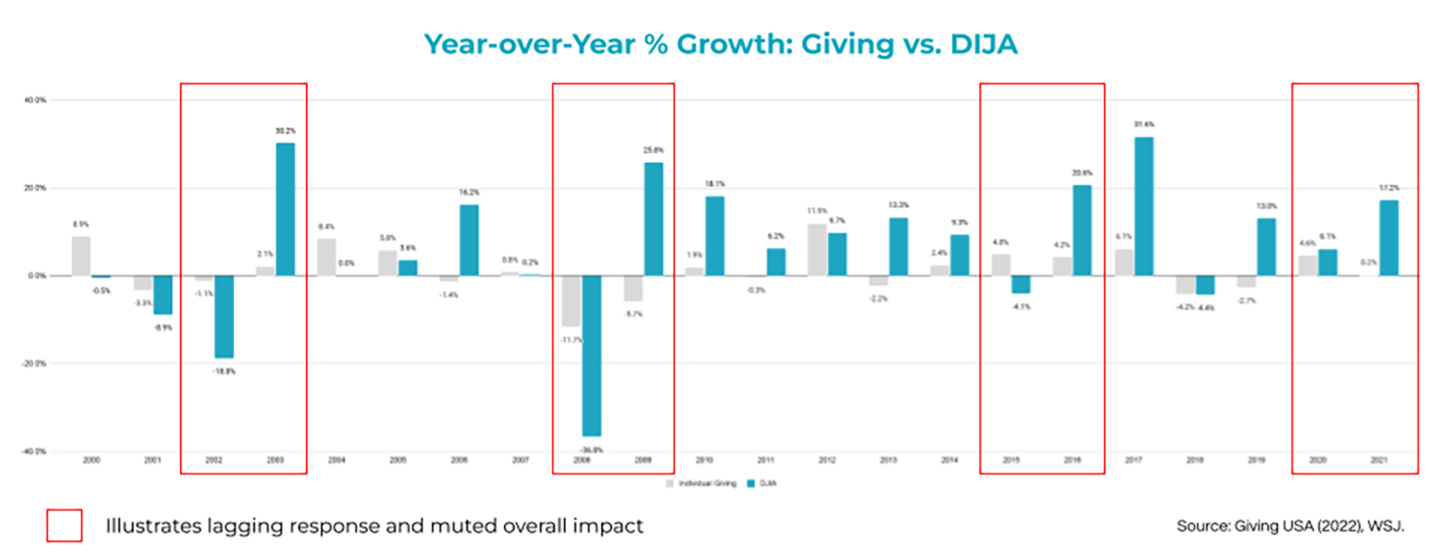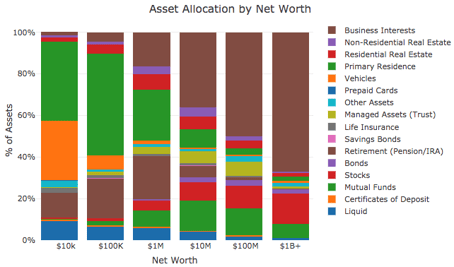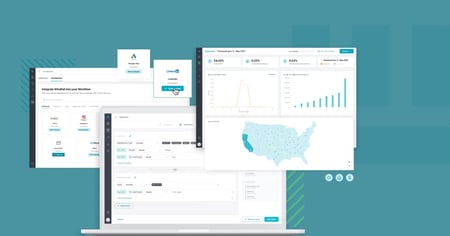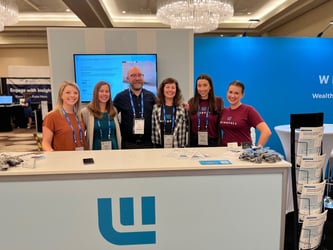Based on a presentation by Windfall CEO, Arup Banerjee
In the last several months the U.S. has seen a rise in inflation, gas prices are high and companies are thinking about hiring freezes and layoffs as they plan for an uncertain economic future. When we look at historical events, we know that rising interest rates can trigger a recession. Although these are warning signs, we are not in a recession yet. But what are some things nonprofits can do to prepare to weather this possible storm?
If we take a step back and look at recent economic performance as far back as 2019 and earlier, the economy as a whole is doing pretty well. We’ve actually seen some growth aside from the last few months. One of the things you’ve probably noticed is that real estate has been booming the last few years and that has started to slow down as interest rates have increased.
On the flip side, unemployment rates have come back down to pre-pandemic levels. Wage increases are happening across the board and companies are struggling to fill positions. However, recent job reports in May have stated that this is diminishing or even reversing those increases because of some of the inflation we are seeing. The reason we are seeing a lot of inflation right now is due to a lot of government spending, the Russia and Ukraine crisis, the infrastructure bill, supply chain issues raising the costs of goods, and relief packages. It’s been about 40 years since we have seen this level of inflation.
As we think about how this impacts consumers, one of those elements we look at is the decrease in demand. This does not mean that we are seeing a decrease in revenue, however. Companies are still turning high profits. This increase in inflation is impacting consumers. People are starting to think about rainy day funds as they plan ahead and rethink that long road trip they had planned.
So what is the government trying to do to curb that? The Fed has increased interest rates as they try to slow the economy to combat inflation. The federal funds rate has increased 75 basis points in the last few months. When interest rates are increased, this makes it harder for everyone, including businesses, to borrow money. Chair of the Federal Reserve, Jerome Powell, has noted that as we diminish demand and cool the economy, a reversal in the job market and higher unemployment may trigger a recession. The stock market is anticipating some of those possibilities now and until we see inflation tempered and an increase in interest rates helping us, you will see those rates impacting the stock market.
Historical Trends
One of the things to consider, which differentiates this period in the economy, is that consumers have more cash than ever before. At the beginning of 2020, there was $13.7 trillion among U.S. consumers. The savings rate during the pandemic increased considerably and In 2022 we’ve seen that number rise to $18 trillion. This is a very significant increase if we look at historical trends. Now consumers are starting to dip into their savings and savings rates have dipped in recent months from 6% to 4.4%. Looking back to March 2021, the market has risen and fallen to where it stands now, at about 96% of where it was at that time. So although the market has retained most of its value we are in negative territory, which is an indicator of what may be happening with the economy.
As we look at previous trends in nonprofit giving since 1990, there has been a lot of growth holistically. The data also shows us what happened to nonprofit giving during the last three recessions of 1990, 2001, and 2008. In the last three recessions giving did decrease that year and the year following a recession.
- In 1990 giving was down 5.7% and .5% in 1991.
- In 2002 the decrease was 3.3% and 1.1%
- In 2008, the decrease was 11.7%, and 5.7% the year following.
That being said these decreases are fairly muted when compared to overall giving during the 30-year span and overall giving increased.

Implications for Nonprofits
If we look at historical giving and year-over-year growth, how does this get adjusted vs. the stock market? Can we learn from those indicators and apply that to what we might see in the next 12-24 months? When looking at the DOW we can see that compared to gains and losses in the stock market (blue bars), the correlated giving increase or decrease is much more muted (grey bars). That is to say that giving is minimally impacted by market volatility, which is a silver lining for our nonprofit friends during the current trends we are seeing.
Despite the stock market minimally impacting individual giving, there is still the perception among consumers that there is less wealth overall. Is this accurate? While that statement is generally correct, we must look at other various aspects of consumer wealth as it is generally hedged in other asset classes. What we see is that stocks only make up a small portion of the wealth of an individual. This continues to be true for high-net-worth individuals. All of this means that fluctuations in the stock market affect overall wealth much less than we tend to think it will.

With all of this being said, and despite the impact on giving likely being small, the truth is that giving does decrease during a recession. So what can we do to set ourselves up for success in the face of a possible recession? Here are our five recommendations.
Data-Driven Strategies for a Volatile Market
Most organizations are not data-driven. It’s a harsh statement but true and to be successful during difficult times for fundraising, you must be efficient. This is where having a data-driven organization will set you up for success, and we are going to tell you how.
Any data-driven organization must start by building a foundation of trustworthy data. Oftentimes there is overlapping data across disparate systems within an organization. Donor and prospect data, CRM data, transaction data, volunteer data, email data, and more. There are often competing data from various departments and locations like regional data at hospitals and universities, all inputting it into a central location. Organizations must first unify the data and enrich it, whether it be with third-party or wealth screening data, to then enable action. Many organizations will go straight to the major gift programs or outreach, but that will be very difficult without all the information about your ideal donor.
Once a foundation of trustworthy and unified data is laid, it’s time to augment your data with deeper intelligence and insights. Doing this helps you develop a 360-degree view of what characteristics define your ideal donor. You should be asking yourself questions like “what is their wealth, likelihood to give, engagement, geographic location, or cohort?” “What is their donation threshold?” “What are our benchmarks and are the success metrics achievable?” The more you can identify about your donor, the more targeted and efficient you can become at finding more individuals like them. There may be a substantial area of untapped opportunity within that segment.
It’s given, even necessary, that your organization has a sizeable dataset. With already stretched resources, combing that data and drawing conclusions from that data will undoubtedly be an expensive and time-consuming process. That’s why it’s important to leverage AI and Machine Learning to drive strategic processes. Leveraging AI can help streamline operations. If you build a model for your organization and its specific goal it WILL help you reach your goals more quickly. With predictive modeling your organization can point out individuals with a higher propensity to give, allowing your team to prioritize those individuals in their fundraising efforts.
When there is a consensus that the data you’re using works and is trustworthy, it’s time to take action across the organization. Start to roll out improvements in your data-driven strategy in a phased approach. Prove to stakeholders that the data works and show how it can increase success rates among your gift officers. This is an opportunity to try it across other channels and measure. Another way to do this is to try the 80/20 rule. Have your team spend 20% of their time focused on these AI-derived audiences and see how it compares to where they are spending the other 80% of their time. It’s important now to orchestrate enhancements across the organization and loop engineering, as this process will require their help.
The final step in this process is to analyze, measure results, and continue to iterate. This is an ongoing process. Data changes, and as you refresh and organize your data (as you should be), you can maintain and refine the process. In this phase, it’s important to continue to train your team on this process and refine your KPI’s as you hone in on your ideal cohorts.
The state of the economy and its outlook remains uncertain, but there are a lot of signals impacting consumers. For us in the nonprofit world, there are others things we can take into consideration. Wealth is not all tied up in the stock market, luckily for us. We also have some cutting-edge tools at our disposal we didn’t have in the prior recessions, in addition to the fact that there is a lot of cash in people’s pockets right now. Screen your entire database. Make sure you look at identification, segmentation, and engagement strategy. With a large list and limited resources, look at propensity modeling and machine learning to get the most “bang for your buck.” Continue to improve and iterate while keeping an eye on your success metrics. As the world changes around us make sure you update and refresh your data and your goals to continue and ensure the success of your team.





